
FAQs About Calandiva: Everything You Need to Know
Calandiva is a specific cultivar of Kalanchoe Blossfeldiana known for its double-flowered blooms and compact growth, a beautiful and versatile plant that’s perfect for adding a splash of color to your home or garden. I’ve had my fair share of experiences with Calandiva, and I want to share some insights and answers to frequently asked questions about this lovely plant.
184 Species in Genus Kalanchoe
How to Care for Calandiva?
Caring for Calandiva is relatively straightforward once you understand its needs. These plants thrive in bright, indirect light. Direct sunlight can scorch their leaves, so I usually place mine in a spot with filtered light. Watering is crucial—Calandiva prefers to be kept on the drier side. I water mine thoroughly when the top inch of soil feels dry. Overwatering can lead to root rot, so it’s better to err on the side of dryness.
Is Calandiva an Indoor or Outdoor Plant?
Calandiva is primarily an indoor plant. It prefers a controlled environment where it can avoid extreme temperatures and direct sun exposure. However, if you live in a mild climate, you can also grow Calandiva outdoors in a shaded area. I’ve found that it adapts well to indoor conditions, making it a great choice for bright rooms or offices.
Are Calandiva Toxic to Cats?
Yes, Calandiva is toxic to cats. The plant contains compounds that can cause gastrointestinal upset if ingested by your feline friends. If you have cats that are prone to nibbling on plants, you might want to keep Calandiva out of their reach or choose a non-toxic plant instead.
Are Calandiva Perennial?
Calandiva is often treated as a perennial in warmer climates, but it’s usually grown as an annual in cooler areas. This means that while it can live and flower for several years in ideal conditions, it’s more commonly enjoyed as a seasonal plant. I’ve seen it last through several seasons in my home, but it’s best to treat it as a short-term investment and enjoy its vibrant blooms while it lasts.
Are Calandiva Plants Poisonous to Dogs?
Calandiva can be toxic to dogs as well. Similar to cats, dogs that chew on the plant may experience digestive issues. If you have pets that might be tempted to snack on your plants, it’s best to keep Calandiva out of their reach or choose a pet-friendly alternative.
How Big Do Calandiva Get?
Calandiva plants generally stay compact, reaching about 6 to 12 inches in height. Their growth is relatively slow, so they don’t require frequent repotting. I’ve found this size makes them perfect for small spaces and tabletops.
How Long Do Calandiva Plants Live?
With proper care, Calandiva can live for several years. However, their typical lifespan is around 2 to 3 years. The key to extending their life is to provide consistent care and avoid common pitfalls like overwatering.
How to Propagate Calandiva?
Propagating Calandiva is quite simple. You can start by taking stem cuttings from a healthy plant. Make sure each cutting has a few leaves and a section of stem. Allow the cuttings to dry for a day or two to form a callus before planting them in a well-draining soil mix. I’ve had success using a mixture of potting soil and perlite. Keep the cuttings in a bright, indirect light and water them sparingly until they establish roots.
How to Prune Calandiva Plant?
Pruning Calandiva helps maintain its shape and encourage new growth. I usually trim off any dead or wilted flowers and leaves. To encourage a fuller plant, pinch back the growing tips to promote branching. This also helps the plant stay compact and bushy rather than leggy.
How Much Sun Does a Calandiva Plant Need?
Calandiva thrives in bright, indirect light. Direct sunlight can cause the leaves to burn, so it’s best to place it in a location where it receives filtered light or a few hours of morning sun. In my experience, a spot near a north or east-facing window works well.
Calandiva vs Kalanchoe
Calandiva and Kalanchoe are often confused, but there are key differences. Calandiva is a specific cultivar of Kalanchoe blossfeldiana known for its double-flowered blooms and compact growth. Kalanchoe, on the other hand, is a broader category that includes various species with different flower forms and growth habits. I’ve found that Calandiva’s unique, ruffled flowers and smaller size make it a standout choice among Kalanchoe varieties.
What to Plant With Calandiva?
If you want to create a vibrant display, consider pairing Calandiva with other low-maintenance plants like succulents or small ferns. Their contrasting textures and colors can make for a striking arrangement. In a container, I like to combine Calandiva with trailing plants like String of Pearls for a cascading effect.
Can You Grow Calandiva Indoors?
Yes, Calandiva is well-suited for indoor growth. It thrives in the controlled environment of a home where it can avoid extreme temperatures and harsh sunlight. Indoors, it’s important to provide it with sufficient light and avoid overwatering.
Benefits of Calandiva
One of the biggest benefits of Calandiva is its long-lasting blooms. It provides a burst of color for months, making it a great addition to any home decor. Plus, its compact size makes it ideal for smaller spaces.
Common Problems with Calandiva
Common issues with Calandiva include overwatering and poor light conditions. Overwatering can lead to root rot, while insufficient light can cause the plant to become leggy and reduce blooming. Regularly checking soil moisture and adjusting light conditions can help prevent these problems.
In summary, Calandiva is a beautiful and relatively low-maintenance plant that can brighten up any space. With the right care, it can thrive indoors and even outdoors in suitable climates. If you’re considering adding Calandiva to your collection, keep in mind its specific needs and benefits to ensure it remains a vibrant part of your plant family.



